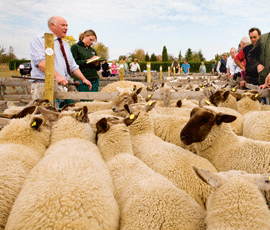Good margin to be had from store lamb trade

Store lamb finishers who take the “guesswork” out of their system can look forward to a winter of good margins, provided their buying-in price is based on close scrutiny of finishing costs and the feeds available.
Although store lambs are averaging around £65 a head – at least £10 up on the year – and finishers face higher bought-in feed costs, EBLEX analysts say net margins (including all non-cash costs) of up to £21 a lamb are possible for those taking a “tight grip” on every aspect of their system.
“Our latest costings for store lamb finishers show the 2011-12 season should be on a par with last year and that means there’s the potential to achieve around £21 a head profit on store lambs finished on the most efficient systems,” says Liz Genever of EBLEX.
At the lower end of the scale EBLEX figures show medium-keep lambs weighing 30-35kg, bought at £60 and costing 20p a day to finish (variable costs) and with fixed costs at £4.90 (excluding non-cash costs such as unpaid family labour), need to be sold at a finished price of £4.20/kg deadweight to leave a margin of £5.15 a lamb. The finishing period should be around eight weeks achieving a weight gain of 6-12kg.
“Finishers need to be aware of every cost involved in the system before they start buying lambs. It’s almost a case of working backwards and assessing what feeds you have available, what it’s going to cost to finish the lambs, the fixed costs and, of course, the impact of mortality. At these prices lamb losses can seriously erode margins,” says Dr Genever.
Despite the EU monetary crisis, market analysts forecast the export demand for UK lamb to continue and for prices to be sustained or even rise marginally throughout the winter – heartening news for store lamb finishers. Lamb exports to France, which currently takes 68% of UK lamb, have dipped slightly this year but the fall is not considered to be significant.
Although store lamb margins have improved over the last two years to the peak of £21 a head, the EBLEX costed average for 2010-11 was £7.50.
“One of the most striking figures from the top third costed finishers was the price they paid for lambs. It was £6 less per lamb compared with the price paid by those achieving the average margin. That could be because they bought more shrewdly or were buying smaller lambs to go on to systems that were better able to finish them more profitably.
“Finishers achieving the average margin were feeding more concentrates, buying bigger lambs and opting for short finishing periods. Within the top third of producers we found more were making more use of forage crops, buying lambs more cheaply and were less dependent on bought-in feed,” says Dr Genever.
Buying smaller long-keep lambs at the lower end of the current market price may seem like a better bet for those recalling the £5.50/kg finished price reached in May, but it could be the season’s biggest gamble.
“If you have enough feed to take them through the winter and you’ve costed it carefully, it may still be an option for some, but it has to be looked at very carefully. Holding out to get £90 a head for these lambs can look very attractive but it’s vital to assess all the costs involved including labour.”
The dry weather in the midlands and South has disrupted this season’s store lamb buying period for finishers reliant on grass and forage crops. Recent weeks have seen store lamb prices firm at many markets – 6,000 lambs sold last week at Bakewell in Derbyshire were up £13 a head on the year to average £66 – but EBLEX urges buyers to look carefully at their feed resources.
“If you are relying on bought-in concentrates, in terms of the cost of dry matter it’s costing you four times more than feeding grass. So if your system is based solely on hopper-fed lambs it’s essential to know what your feed is going to cost and how it should influence your buying-in price,” says Dr Genever.
Store lamb prices have been steadily rising this autumn – up £5 a head per week at some markets – and with little on the horizon to jitter the finished lamb trade it’s a clear sign of buyers’ confidence.
With supplies of the best short-keep lambs getting tighter, auctioneers say buyers are prepared to pay more to exploit late-season grass and forage crops.
Auctioneer Alastair Sneddon of Bagshaws at Bakewell said prices had risen by £6 a head during the middle of October. “Store cattle are expensive and that’s making more buyers look at lambs. Keep has been tight up until know so it’s all contributing to the strong trade.”
